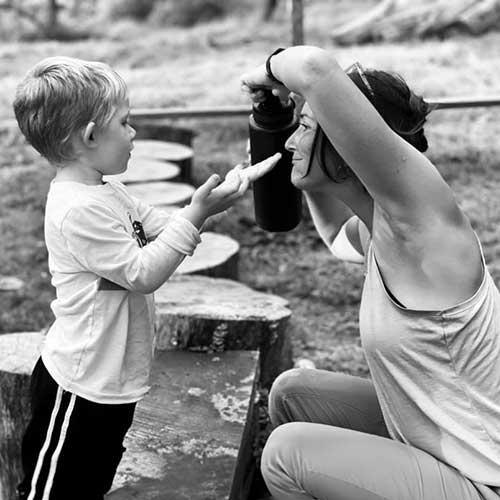LAMP Certified Practitioner (LCP) Profile: Stephannie Brajot, M.A., CCC-SLP
Speech-Language Pathologist Stephannie Brajot began her career in a busy clinic with children who had been working on single sounds for months with little-to-no functional progress. “Their frustration was palpable,” recalls Stephannie. “I had to find another way to help get kids communicating in ways beyond speech and simplified pictures with no nuance or range.”
She discovered LAMP Words for Life® in 2012 after disappointing experiences with other speech-generating devices (SGDs). “I could see right away that this design was simultaneously uniform yet customizable, plus it was easy to use,” she says. “It was my new path forward, and it wasn't long before I became LAMP certified.”
Language development in a safe environment
Ten years ago, Stephannie founded Pivot Point Speech Therapy in Athens, Ohio, where she uses an iPad® with the LAMP Words for Life app to help her clients – most of whom are autistic, non-speaking children ages three to 10.
“I believe that birth through age five is the most critical stage of development and that this is where I can have the most influence on cultivating positive and functional neural pathways through coregulation and PLAY!” she says. Pivot Point’s therapy yurt and farm – which she calls a “total paradigm shift both professionally and personally” – creates an environment to build relationships with clients through a variety of shared experiences like riding a pony, throwing rocks in the pond, or just walking through the woods. They use LAMP to say “let’s go” or “ride horse” or “more that,” but the kids also have access to quiet spaces to process and be still when needed.
“This fluid environment where we can be inside or outside, with animals or without, running or at the table, in sand or water, and so on has been so critical to balancing emotional state, sensory regulation, and cognitive load – not only for the kids, but also the parents,” insists Stephannie.
She’s tried to create a place where both kids and adults can be their authentic selves in an emotionally safe environment. “In my experience there's no better place to do that than in nature and/or with animals. We have rabbits, dogs, horses, and sheep that I build many activities around, even if it's just saying, "I don't like horses!" she says.
Child-led engagement with AAC
Like any therapy approach, learning LAMP Words for Life has its challenges. Stephannie explains that many people assume that learning where all the words are will be the hard part of learning LAMP WFL, but that's actually the easy part. Implementation of the device and inspiring a child to use it independently, in meaningful contexts for the child is the most difficult part. “Many parents, teachers, and well-meaning caregivers try to force the device too much, with too little modeling and too high expectations,” says Stephannie. “Instead, I pay close attention to what motivates each child and what he or she is thinking about.”
This approach has led Stephannie to observe many breakthroughs with LAMP over the years. One of those moments came from a non-speaking four-year-old boy that Stephannie described as a touching experience she will never forget. This boy had grown to love Stephannie’s horse, Willow. When his family's dog, Onyx, passed away, even though we had never used the words “death" or "died," he independently hit the name of the horse who had died six months earlier. “He hit ‘want Onyx Willow’ over and over,” recalls Stephannie. “We really believe he was saying he missed these beloved pets who had passed away. It was remarkable.”
Providing parent support
She also says when providing therapy to autistic children, she spends as much if not more time molding the parents’ behaviors and perspectives to help the child. “Parents also need encouragement, patience, and kindness,” says Stephannie. “Parents and caretakers are exhausted, worried, tired, and often feel their child’s difficulty may confirm they are ‘a terrible parent.’ Even if it’s the furthest thing from the truth, these feelings are real and can not be ignored by an effective therapist.”
For parents who may find their child with a SGD in the future, Stephannie encourages them to find a speech language pathologist (SLP) who views their child through a strength-based model and embraces neurodiversity. She also wants people to remember that the device is for the child’s voice, thoughts, feelings, and questions. “We must think about what the child wants to say, not what we the adults want,” says Stephannie. “For example, a teacher wanted me to put the word ‘sit’ on a child's device. I said, ‘Only if you can give me an example of when the child needs to use the word 'sit', but he did not.’”
The combination of Language Acquisition through Motor Planning™ (LAMP) therapy approach and Stephannie’s outdoor, play-based, collaborative therapy environment results in the kids and a therapist who make significantly more progress than they did in a more traditional clinical space. “When I see the spark in a child's eye when they realize what these new skills mean, or when I see a parent have their first real conversation with their child, it is transformative, inspiring, and very moving,” she says.
Learn more about the Language Acquisition through Motor Planning (LAMP) therapy approach and how to become a LAMP Certified Professional.

